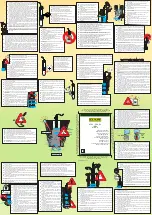
© Copyright 2021 Zoeller
®
Co. All rights reserved.
7
TROUBLESHOOTING INFORMATION
1.
DC Pump won’t run.
(a) Check for proper connections.
(b) Check all wire terminal points. Clean if required.
(c) Check for low battery. Service battery if required.
(
d
) Check
30 amp fuse on controller. If fuse is blown, replace with 30 amp
automotive blade fuse.
(
e
)
Remove pump. Check for obstruction in pump preventing impeller from
rotating.
(f) Float switch was not “on” for more than 1 second. A quick up/down of
a switch will not turn the pump on because the controller is designed
with “splash activation protection”.
(g) During a float fault, the operational float is disregarded until the controller
is reset.
2.
Pump runs but moves very little or no water.
(a) Check for low battery. Battery will recharge if green System Ready
LED indicates power has been restored and the float switch is in the
off position.
(b) If immediate usage is required, remove and replace dead battery with
a fully recharged battery.
(c) Under certain conditions the pump may continue to run on a low battery
without sufficient power to remove water. Pump will stop running once
battery is below minimum voltage threshold.
(d)
CAUTION
Weak batteries can be recharged but may not store
sufficient energy for full service. A weak, recharged battery can only
be detected by reduced pumping time or by professional load testing
equipment. The battery should be checked by a qualified battery dealer.
(e) Verify pump is connected completely.
(f) Check to make sure pump weep hole is clear and unit is not airlocked.
(g) Make sure discharge piping is not blocked.
3.
Pump cycles too frequently.
(a) Check positions of rubber stops on the operational float rod and adjust
if necessary.
4.
Pump runs, but pumps water intermittently.
(a) Pump may be air locking. Check flow of water incoming to sump. If water
is entering the sump at a high velocity creating a turbulent condition, a
mixture of air and water may cause a complete or partial air lock and
reduce or stop the flow of water in the discharge pipe.
(b) Baffle the incoming stream of water to reduce turbulence. Diverting
water stream against wall of basin usually corrects an air lock problem.
5. Water level stays high. DC Pump continues to run.
(a) Battery is low or pump may have blockage in screen, impeller, or piping
system.
(b) If power has been restored and water in sump remains high check
primary pump. Service if required.
6. Alarm sounds during battery recharge cycle.
(a) To silence alarm if alarm will not reset, unplug the charger from 115 V
wall outlet, then disconnect the black lead from charger on negative (-)
battery post. Check battery. Replace if necessary. Reconnect and refer
to Installation Instructions.
To perform a Factory Reset, hold the Silence and Test buttons together. A Factory Reset restores all settings to their original setting. Be sure all switches,
pump, battery and AC connections are good before the Factory Reset.
ELECTRICAL PRECAUTIONS-
Before servicing a pump, always shut off the main power breaker and then unplug the pump - making
sure you are wearing insulated protective sole shoes and not standing in water. Under flooded conditions, contact your local electric company or
a qualified licensed electrician for disconnecting electrical service prior to pump removal.
Submersible pumps contain oils which becomes pressurized and hot under operating conditions.
Allow 2-1/2 hours after disconnecting before
attempting service.
If the above checklist does not uncover the problem, consult the factory - Do not attempt to service or otherwise disassemble pump.
SERVICE CHECKLIST- PRIMARY PUMP
CONDITION
COMMON CAUSES
A.
Pump will not start or run.
Check fuse, low voltage, overload open, open or incorrect wiring, open switch, impeller or seal bound mechanically, motor or
wiring shorted. Float assembly held down. Switch damaged or out of adjustment.
B. Motor overheats and trips
overload or blows fuse.
Incorrect voltage, negative head (discharge open lower than normal) impeller or seal bound mechanically, motor shorted.
C. Pump starts and stops too often.
Float switch tether length too short, check valve stuck open, or none installed in long distance line, overload open, bidding,
sump pit too small.
D. Pump will not shut off.
Debris under float assembly, float bound by basin sides or other, switch, damaged or out of adjustment.
E. Pump operates but delivers little
or no water.
Check inlet, strainer housing, discharge pipe, and vent holes for obstructions. Discharge head exceeds pump capacity. Low
or incorrect voltage. Incoming water containing air or causing air to enter pumping chamber.
F. Drop in head and/or capacity after
a period of use.
Increased pipe friction, clogged line or check valve. Abrasive material and adverse chemicals could possibly deteriorate impeller
and pump housing. Check discharge line. Remove base and inspect.
G. If tank or fittings leak.
Carefully tighten pipe joints (use pipe dope) and screws. Check gasket location, tighten lid evenly. Do not over tighten fittings
or screws.


























